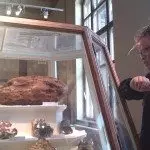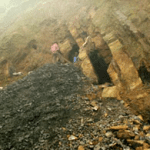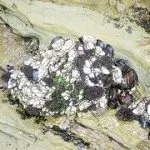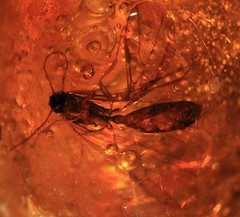Continued from Part 1:
Here are some clues to how amber is made:

•Flood conditions are known to cause trees to make extra resin (you can find out about it by reading this paper from the University of Georgia)
•Amber sometimes is found in chunks weighing 21 pounds [9.7 kg] or more. Whatever happened, those trees were oozing like crazy (if you have enough money, you can easily buy a fairly big chunk of amber).
•Some forms of amber are known to be from a badly damaged tree (click HERE to see a drawing of what this damage and resin looks like).
•We know amber came from trees, but we never find amber with whole trees. The wood found with it is always broken to bits.

•Amber is sometimes found with soft coal (called lignite) which is made from bark.
•Amber is often found covered with “marl” or limestone clay. This was laid down as thick, heavy mud
•Other times it is covered with sandstone: another rock made from wet sediment.
•Often, geologists can tell the amber ended up far away from where the trees came from. Something moved them far from the original forests and then buried them. What geologic process has that kind of power?
Water
Could a quiet forest make amber like this? Hardly! You need water. Resin doesn’t melt away in water right away. It stays sticky and scientists have seen it collect bugs and things when dropped into water.

Scientists have also realized you need to put the resin in water to explain all the diatoms, sponge bits, water bugs, shrimp, oysters, barnacles, and other sea creatures found in it.
Some amber has wood bits, mushroom caps, or flowers stuck in it. All sorts of land creatures were sometimes trapped inside, such as lizards, frogs, worms, something like a shrew, bird feathers, and fur. But, the most common fossils we find preserved are insects.

Many times, the insects and spiders found in amber are just like their living cousins. They haven’t changed at all. Others are a bit different, but are still easy to recognize. These things leave two options: you can either believe these bugs evolved a lot before 100 million years ago and then just stopped changing, or that they weren’t buried so very long ago and were created a lot like we see today.
God is not a man, so he does not lie. He is not human, so he does not change his mind. Has he ever spoken and failed to act? Has he ever promised and not carried it through? Numbers 23:19 NLT
The BBC has a couple short videos on amber including mining in the Dominican Republic and how resin oozes out to trap bugs and then gets buried under water. The first one only mentions “30 million years ago” once at the end, but you hear it a lot on the second one. You still wouldn’t want to miss the frog and lizard in amber or the great footage of resin in water, though.
It’s just one more example of our story being a lot like theirs, just way faster!






